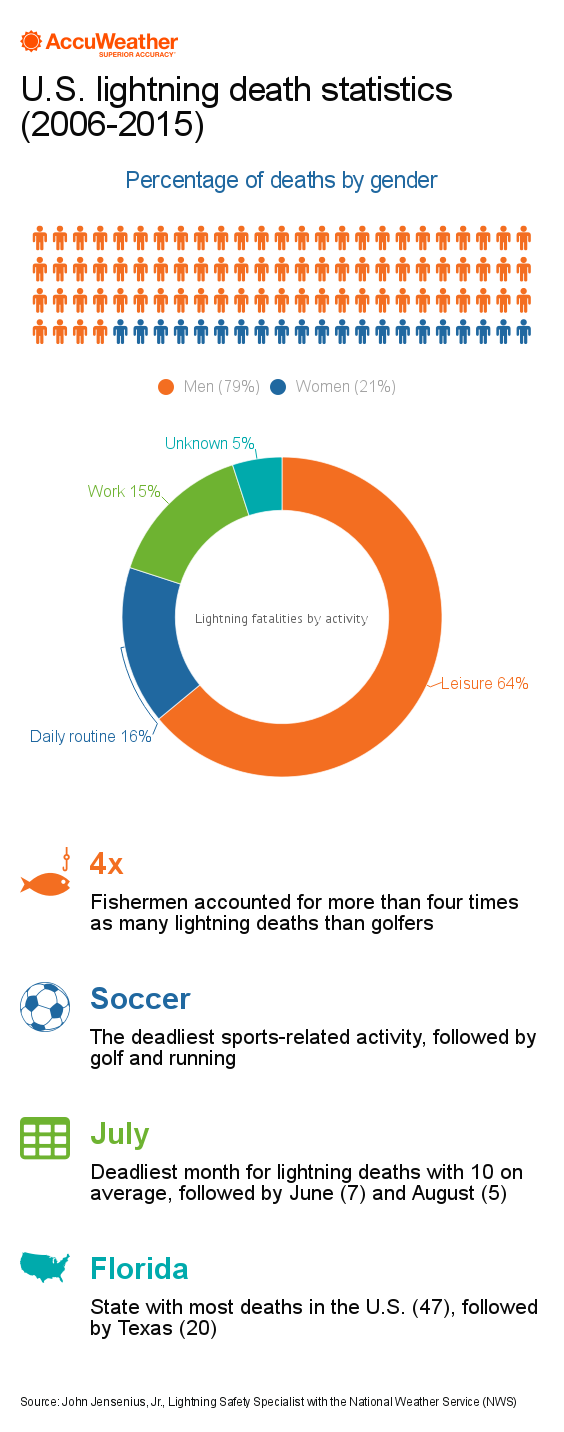By Kristina Pydynowski, Senior Meteorologist
July 23,2016; 2:00PM,EDT
Lightning killed a teenager on Friday, the second teen lightning death in three days.
Brooklyn Reynolds, 14, was struck and killed by lightning on Friday as she was riding a jet ski in the Flaming Gorge Reservoir that straddles the Utah-Wyoming border.
Reynolds was riding on the watercraft with her stepmother, who was critically injured by the lightning strike and airlifted to a hospital in Salt Lake City, according to the Associated Press.
Reynolds is the second teen struck and killed by lightning over the course of three days. A 17-year-old boy died after being struck by lightning when hiking in northern Arizona on Wednesday.
The number of lightning deaths across the U.S. now stands at 18, according to John Jensenius, Jr., Lightning Safety Specialist with the National Weather Service (NWS).
On average, 49 people are killed by lightning in the U.S. each year. Hundreds more are severely injured, according to the NWS.
With thunderstorms set to rattle several parts of the nation this week, more lives will be at risk.
Anyone planning to spend time outdoors this summer are urged to review key lightning safety tips to avoid becoming another lightning death statistic.
"While only a small number of thunderstorms become strong enough to produce damaging winds, large hail and tornadoes, every thunderstorm produces lightning," AccuWeather Meteorologist Brian Lada said.
RELATED:
Severe weather center: Recent lightning strikes
INFOGRAPHIC: Electrifying lightning myths and facts unveiled
3 ways to help pets cope with fear of storms
An estimated 25 million flashes of lightning strike every year across the U.S.
"Many lightning strikes are harmless and have very little effect on people and the environment," Lada said. "However, people should keep in mind that it only takes one to endanger lives and cause damage to property."
As soon as thunder is heard, the danger of being struck by lightning is present. A bolt of lightning can strike people and buildings 10 miles away from where it is raining. In extremely rare cases, lightning has been detected almost 50 miles from the thunderstorm.
If on a beach or in other situations when it is difficult to hear thunder, AccuWeather MinuteCast can aid alert people to impending thunderstorms.
Make yourself the smallest target possible if you are caught outdoors during a thunderstorm. Crouch down with your knees together and your weight on the balls of your feet. Put your head down and cover your ears. Do not lie flat. The goal is to minimize your height and your body's contact with the ground.
Never seek shelter underneath a tree. The lightning charge can strike the tree, then cause fatalities up to 100 feet away. Avoid lakes, streams and swimming pools since water conducts electricity.
An umbrella will provide protection from a thunderstorm's rain but could also act as a lightning rod.
A sturdy and enclosed building or a vehicle is the safest place to be during a thunderstorm. Water, windows, plumbing and electrical appliances should be avoided. It is safer to use a cell phone than a cord phone when inside.
"It is a common myth that lightning is attracted to metal," AccuWeather Meteorologist Becky Elliott said. "While metal objects don't attract lightning, they are extremely good conductors of dangerous electricity."
"Lightning usually tries to find the quickest path to the ground. If that path happens to be through anything that conducts electricity, including metal objects and phone cords, the electricity from the bolt will travel easily to whoever is holding it."

The metal frame of a vehicle is what protects people during a thunderstorm, not the rubber tires. Anyone riding a motorcycle or bicycle should seek shelter when a thunderstorm threatens.
Remain inside for 30 minutes after the last rumble of thunder is heard.
If you are with someone who gets struck by lightning, there is no threat of electrocution from touching him/her.
"Cardiac arrest and irregularities, burns and nerve damage are common in cases where people are struck by lightning," according to the NWS.
"However, with proper treatment, including CPR if necessary, most victims survive a lightning strike."
AccuWeather Enterprise Solutions provides lightning warnings and notifications to numerous outdoor venues and events in order protect event goers and employees as well as property. The warnings are customized to businesses' precise geographic area and provide crucial lead time to dangerous lightning strikes.
No comments:
Post a Comment